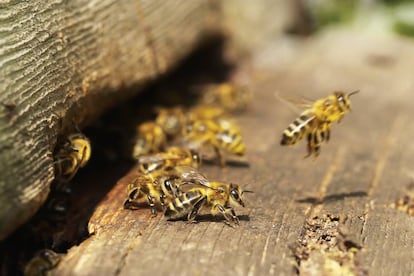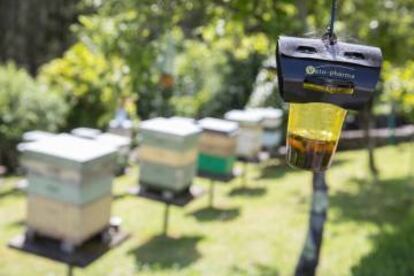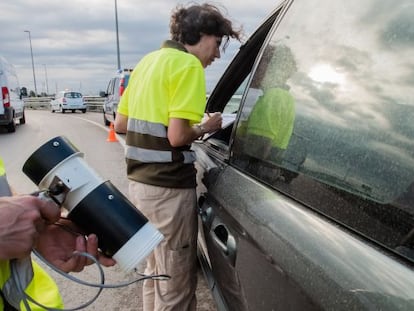What is going on with Europe’s bees?
Existing data is either inconsistent or non-existent, say experts at interdisciplinary summit in Brussels
For many plants, bees are their only aid to reproduction. Their hair-covered bodies easily transport pollen from the masculine parts of a flower to the feminine areas, either on the same plant or another.

This is the way reproduction works with plant species such as the strawberry, whose fruit requires at least 21 visits by bees in order to become plump and tasty, according to United Nations calculations.
Bees are not the only pollinating insects in the world, but they are vital to crops such as alfalfa, almonds, cucumbers and strawberries.
The European Union is worried. In recent years, various scientific studies have highlighted the decline in bee populations due to a proliferation of threats: habitat destruction; abuse of pesticides, which have now been temporarily banned in the EU; invading species such as the Asian hornet, which attacks beehives; the Varroa mite, which sucks up bees’ internal fluids; the Nosema apis parasite, which disrupts their digestive tract; and last but not least, climate change.
Most existing scientific studies are very limited in their geographical scope
But the main problem is that nobody knows what’s really happening out there. There simply isn’t enough reliable data.
“Our goal is to bring together beekeepers, farmers, industry, scientists, risk assessors and managers, citizens and policy makers to analyze how to best collect data to evaluate the state of bee health in Europe in a more realistic way,” said Simon More, a vet with University College Dublin at the opening of the scientific symposium Towards a European Bee Partnership, co-organized in Brussels on Monday by the European Food Safety Authority (EFSA).
The gathering was an interdisciplinary attempt at shedding light on an industry that is often opaque due to a combination of varying interests.

The overarching message was clear: we need to collect a lot more data on what is happening, and above all, to share it. But Germany’s Walter Haefeker, president of the European Professional Beekeepers Association (EFPA), argued that “beekeepers need privacy.”
His organization defends the use of anonymous data because sharing information about problems at a given apiary could ruin its business.
Miguel Ángel Miranda, a zoologist with the University of the Balearic Islands, identified another problem: the abundance of “weekend beekeepers.” This is an issue in Spain, where there are 24,755 beekeepers, of whom only 19% are professionals, according to the Ministry of Agriculture. Miranda says that this leads to some treatments being erroneously applied at many hives, creating resistance against disease.
Existing numbers have little to do with the alarmist figures used by some environmental groups
Laszlo Kuster of the European Commission’s Directorate-General for Health and Food Safety, detailed the magnitude of the challenge by recalling the results of the first surveillance program on honeybee colony mortality rates in 17 EU countries. That project, named Epilobee, analyzed 176,860 bee colonies using an established methodology, but even in those conditions, a lot of the data was not collected in a harmonized way. “Even with the best preparation, the data is insufficient,” said Kuster.
Epilobee’s results in the winter of 2013-2014 showed mortality rates of 5% in Spain, 14% in France and 15% in Sweden. A year earlier, when the winter was longer and colder, rates reached 10%, 14% and 29%, respectively.
In any event, these numbers have little to do with the alarmist figures used by some environmental groups, although the vast amount of information collected by Epilobee is still being processed. Program inspectors noted beekeeping practices at every hive, recorded clinical manifestations of parasitical and infectious diseases, and took samples. The study focused on domesticated bees, of which there is a single species in Europe. But there are 1,884 wild species.
The biologist and computer scientist Arthur Thomas came to the world of bees a few months ago. Thomas, of the Oxford Internet Institute, is an expert at creating predictive models about the future behavior of biological systems. He says that he had “no idea” about the complexity of the problems facing bees, but that what truly perplexed him was something else.
“The availability of data is surprisingly scarce,” he notes. “Even at the national level, it is complicated getting your hands on data. Either it is inconsistent or it doesn’t exist.”
Most existing scientific studies are very limited in their geographical scope, and only look at one or two variables, not the interactions among all the existing threats. The industry knows that things are not going to change overnight. Ana Afonso, a Portuguese vet who leads the emerging risk team at EFSA, summed it up: “We’re not about to get a Google Bees next year, with real-time information.”
English version by Susana Urra.
Tu suscripción se está usando en otro dispositivo
¿Quieres añadir otro usuario a tu suscripción?
Si continúas leyendo en este dispositivo, no se podrá leer en el otro.
FlechaTu suscripción se está usando en otro dispositivo y solo puedes acceder a EL PAÍS desde un dispositivo a la vez.
Si quieres compartir tu cuenta, cambia tu suscripción a la modalidad Premium, así podrás añadir otro usuario. Cada uno accederá con su propia cuenta de email, lo que os permitirá personalizar vuestra experiencia en EL PAÍS.
¿Tienes una suscripción de empresa? Accede aquí para contratar más cuentas.
En el caso de no saber quién está usando tu cuenta, te recomendamos cambiar tu contraseña aquí.
Si decides continuar compartiendo tu cuenta, este mensaje se mostrará en tu dispositivo y en el de la otra persona que está usando tu cuenta de forma indefinida, afectando a tu experiencia de lectura. Puedes consultar aquí los términos y condiciones de la suscripción digital.
More information

The silent but deadly trail of the Asian hornet in Spain

The invasion of the winged insects
Archived In
Últimas noticias
Most viewed
- Alain Aspect, Nobel laureate in physics: ‘Einstein was so smart that he would have had to recognize quantum entanglement’
- Mexico’s missing people crisis casts a shadow over World Cup venue
- Why oil has been at the center of Venezuela-US conflicts for decades
- Trump clarifies who is ultimately in charge in Venezuela: ‘Me’
- Mexico seeks to shore up its defenses following US incursion in Venezuela









































